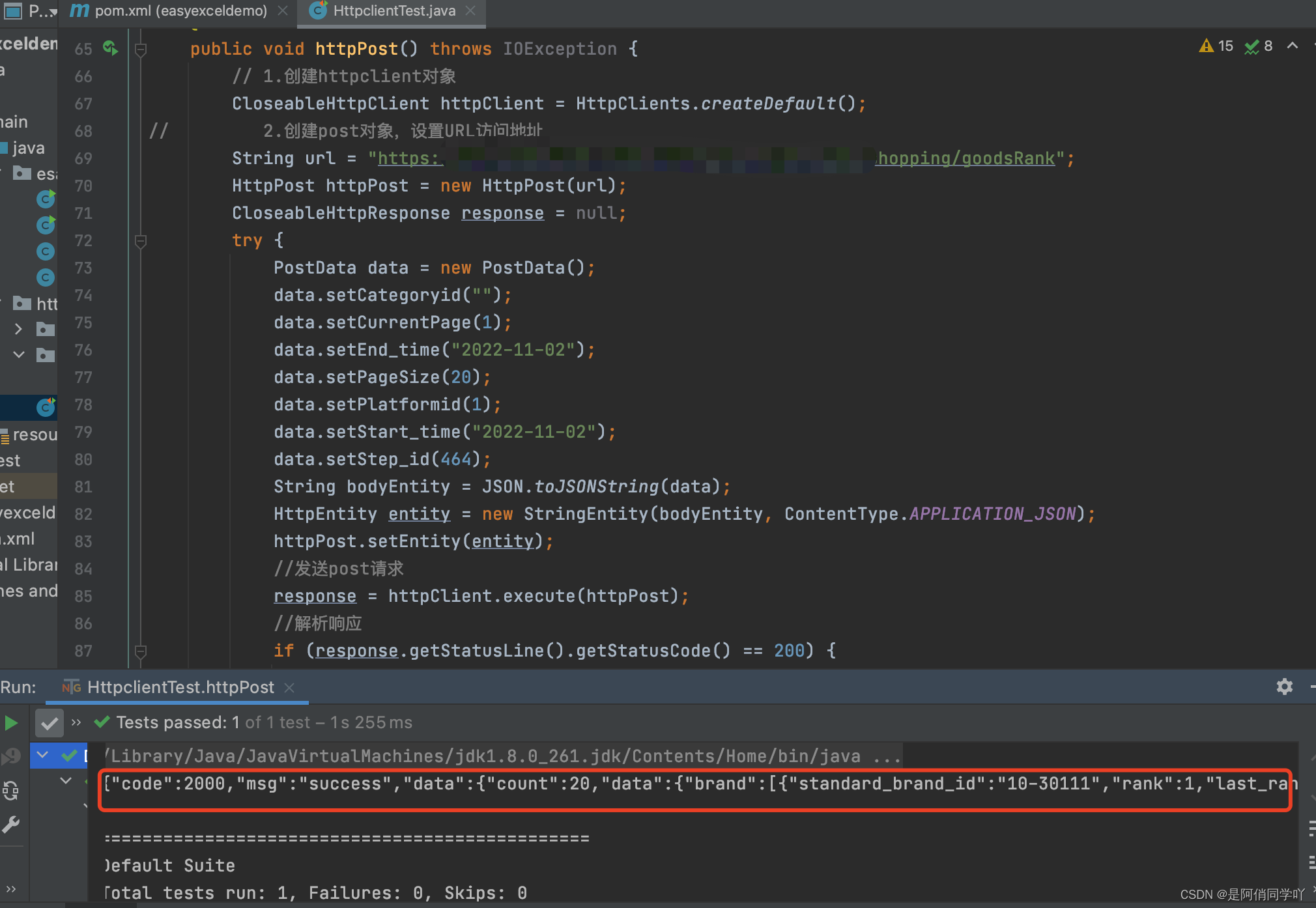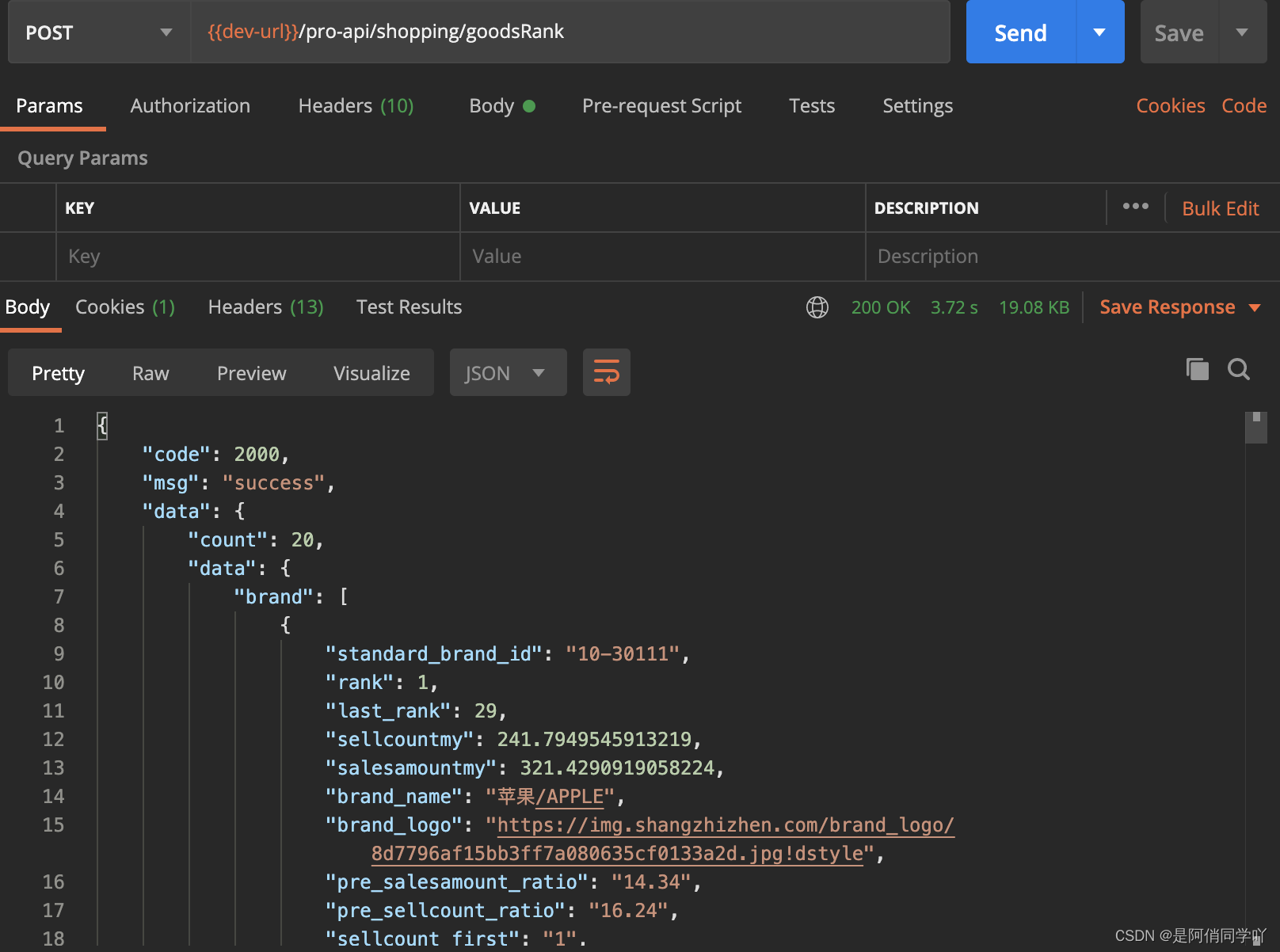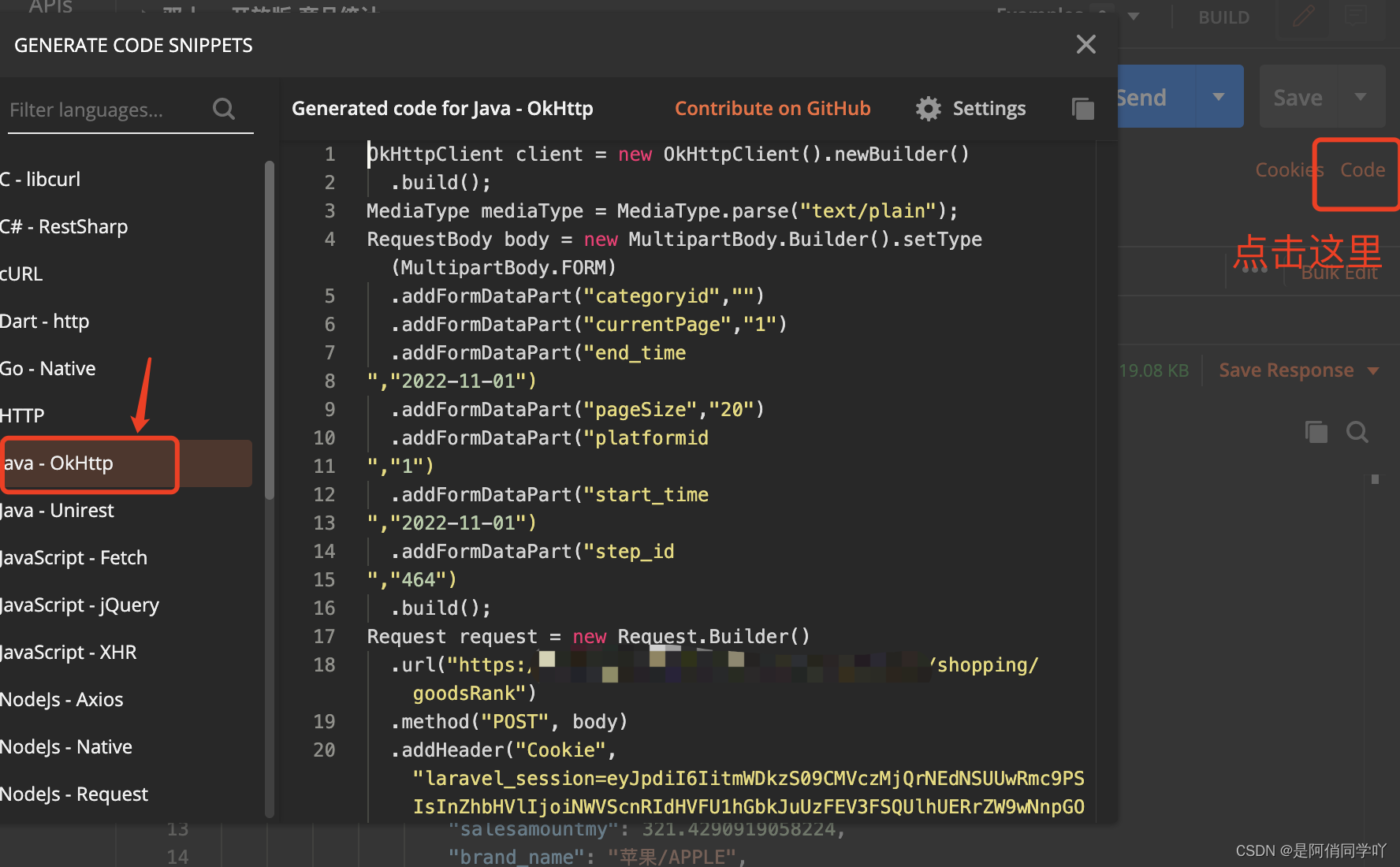httpclient发送Get请求和Post请求
创建HttpClient发送请求、接收响应
Get请求简介
- 1). 创建HttpClient对象,可以使用
HttpClients.createDefault(); - 2). 如果是无参数的GET请求,则直接使用构造方法
HttpGet(String url)创建HttpGet对象即可; - 3)如果是带参数GET请求,则可以先使用
URIBuilder(String url)创建对象,再调用addParameter(Stringparam, String value)`, 或setParameter(String param, String)
value)来设置请求参数,并调用build()方法构建一个URI对象。 - 4). 创建HttpResponse,调用HttpClient对象的
execute(HttpUriRequest
request)发送请求,该方法返回一个HttpResponse。调用HttpResponse的getAllHeaders()、getHeaders(String
name)等方法可获取服务器的响应头; - 5)调用
HttpResponse的getEntity()方法可获取HttpEntity对象,该对象包装了服务器的响应内容。程序可通过该对象获取服务器的响应内容。通过调用getStatusLine().getStatusCode()可以获取响应状态码。 - 6). 释放连接。
构建一个Maven项目,引入如下依赖
<!-- https://mvnrepository.com/artifact/org.apache.httpcomponents/httpclient --> <dependency> <groupId>org.apache.httpcomponents</groupId> <artifactId>httpclient</artifactId> <version>4.5.8</version> </dependency>get无参数
如果是无参数的GET请求,则直接使用构造方法HttpGet(String url)创建HttpGet对象即可
public class DoGET { public static void main(String[] args) throws Exception { // 创建Httpclient对象 CloseableHttpClient httpclient = HttpClients.createDefault(); // 创建http GET请求 HttpGet httpGet = new HttpGet("http://www.baidu.com"); CloseableHttpResponse response = null; try { // 执行请求 response = httpclient.execute(httpGet); // 判断返回状态是否为200 if (response.getStatusLine().getStatusCode() == 200) { //请求体内容 String content = EntityUtils.toString(response.getEntity(), "UTF-8"); //内容写入文件 FileUtils.writeStringToFile(new File("E:\\devtest\\baidu.html"), content, "UTF-8"); System.out.println("内容长度:"+content.length()); } } finally { if (response != null) { response.close(); } //相当于关闭浏览器 httpclient.close(); } }}get有参数
如果是带参数GET请求,则可以先使用URIBuilder(String url)创建对象,再调用addParameter(Stringparam, String value)
public class HttpclientTest { @Test public void httpGet() throws IOException { // 1.创建httpclient CloseableHttpClient httpClient = HttpClients.createDefault(); //2. 创建HttpGet,设置URL访问地址 String urlTest = "https://XXXX/XXX/shopping/platformInfo?platformid=7"; HttpGet httpGet = new HttpGet(urlTest); // 3. 请求执行,获取响应 CloseableHttpResponse response = httpClient.execute(httpGet); //解析响应 if (response.getStatusLine().getStatusCode() == 2000) { String content = EntityUtils.toString(response.getEntity(), "UTF-8"); System.out.println(content.length()); } // 4.获取响应实体 HttpEntity entity = response.getEntity(); System.out.println(EntityUtils.toString(entity, "utf-8")); response.close(); httpClient.close(); }代码中使用的是公司接口,请求URL前缀就XXX表示了,get请求如图所示
运行结果:我们已经看到get接口成功返回一条数据

Post请求简介
- 1). 创建HttpClient对象,可以使用
HttpClients.createDefault(); - 2). 如果是无参数的POST请求,则直接使用构造方法HttpPost(String url)创建HttpPost对象即可;
- 3)如果是带参数POST请求,先构建HttpEntity对象并设置请求参数,然后调用setEntity(HttpEntityentity)创建HttpPost对象。
- 4). 创建HttpResponse,调用HttpClient对象的
execute(HttpUriRequest
request)发送请求,该方法返回一个HttpResponse。调用HttpResponse的getAllHeaders()、getHeaders(String
name)等方法可获取服务器的响应头; - 5)调用
HttpResponse的getEntity()方法可获取HttpEntity对象,该对象包装了服务器的响应内容。程序可通过该对象获取服务器的响应内容。通过调用getStatusLine().getStatusCode()可以获取响应状态码。 - 6). 释放连接。
post携带JSON参数
如果是带JSON参数POST请求,先构建HttpEntity对象并设置请求参数,因为我们的参数是JSON格式的,需要将请求对象转换成string类型的,然后调用setEntity(HttpEntityentity)创建HttpPost对象
首先我们先创建一个请求实体类PostData,代码如图所示
public class PostData { private String categoryid; private int currentPage; private String end_time; private int pageSize; private int platformid; private String start_time; private int step_id; public String getCategoryid() { return categoryid; } public void setCategoryid(String categoryid) { this.categoryid = categoryid; } public int getCurrentPage() { return currentPage; } public void setCurrentPage(int currentPage) { this.currentPage = currentPage; } public String getEnd_time() { return end_time; } public void setEnd_time(String end_time) { this.end_time = end_time; } public int getPageSize() { return pageSize; } public void setPageSize(int pageSize) { this.pageSize = pageSize; } public int getPlatformid() { return platformid; } public void setPlatformid(int platformid) { this.platformid = platformid; } public String getStart_time() { return start_time; } public void setStart_time(String start_time) { this.start_time = start_time; } public int getStep_id() { return step_id; } public void setStep_id(int step_id) { this.step_id = step_id; }} @Test public void httpPost() throws IOException { // 1.创建httpclient对象 CloseableHttpClient httpClient = HttpClients.createDefault();// 2.创建post对象,设置URL访问地址 String url = "https://XxX/XxX/shopping/goodsRank"; HttpPost httpPost = new HttpPost(url); CloseableHttpResponse response = null; try { PostData data = new PostData(); data.setCategoryid(""); data.setCurrentPage(1); data.setEnd_time("2022-11-02"); data.setPageSize(20); data.setPlatformid(1); data.setStart_time("2022-11-02"); data.setStep_id(464); String bodyEntity = JSON.toJSONString(data); HttpEntity entity = new StringEntity(bodyEntity, ContentType.APPLICATION_JSON); httpPost.setEntity(entity); //发送post请求 response = httpClient.execute(httpPost); //解析响应 if (response.getStatusLine().getStatusCode() == 200) { //获取响应数据 entity = response.getEntity(); System.out.println(EntityUtils.toString(entity, "utf-8")); } }catch (IOException e){ e.printStackTrace(); } }运行结果:

post携带表单参数
post请求传递参数的形式是将参数放入表单请求体中,然后将表单对象放入请求体中传递。
//1.获得一个httpclient对象CloseableHttpClient httpclient = HttpClients.createDefault();//2.生成一个post请求HttpPost httpPost = new HttpPost("http://www.baidu.com/");//3.请求参数添加到请求体中,表单提交List<NameValuePair> nvpList = new ArrayList<NameValuePair>();nvps.add(new BasicNameValuePair(key, val));UrlEncodedFormEntity formEntity = new UrlEncodedFormEntity(nvps, charset);httpPost.setEntity(formEntity);//4.执行get请求并返回结果CloseableHttpResponse response = httpclient.execute(httpPost);try { //5.处理结果响应体 HttpEntity entity = response.getEntity();} finally { response.close();}postman自动生成OKhttp代码
首先在postman编写好post请求的URL,请求参数,请求方式,请求头

点击sends按钮右侧的code弹窗展示,如图所示

框里面的代码就是自动生成的,我们可以复制代码到idea中,需要在maven`装下OKhhtp的依赖
官网连接:https://mvnrepository.com/
OkHttpClient client = new OkHttpClient().newBuilder() .build(); MediaType mediaType = MediaType.parse("text/plain"); RequestBody body = new MultipartBody.Builder().setType(MultipartBody.FORM) .addFormDataPart("categoryid","") .addFormDataPart("currentPage","1") .addFormDataPart("end_time ","2022-11-01") .addFormDataPart("pageSize","20") .addFormDataPart("platformid ","1") .addFormDataPart("start_time ","2022-11-01") .addFormDataPart("step_id ","464") .build(); Request request = new Request.Builder() .url("https://XXX/XXX/shopping/goodsRank") .method("POST", body) .addHeader("Cookie", "laravel_session=eyJpdiI6IkRxcWx6M201UHRWMWFWeDY3b0RURmc9PSIsInZhbHVlIjoid0pSM241cmgvRUk5WndHTnc2azlzNFpHVDh6MCt5R1pSV21pQXRPRDB1eEpyMThNZVUrelRKYzJHSVUzNHp3T290RHppOVNvSFZ3Z2VCQ2g4SEFQUjBXSGpRL3VkcUJiRUFzRGc5b21BRnhOUUwzUkNENlhzUEJlVGtWZkhZNGoiLCJtYWMiOiIyYzM1NDhkYzQ0YmZiNjQ5OWIwZjg1NDA3NTYxZTcyM2IyODAxNWI1ZGU4NmEzOTE2YjRmOTBjYzQzMzUyNjY1In0%3D") .build(); Response response = client.newCall(request).execute(); System.out.println(response); }OKhttp的语法跟httpclient差不多,都是http工具类
来源地址:https://blog.csdn.net/weixin_42274846/article/details/127669296
免责声明:
① 本站未注明“稿件来源”的信息均来自网络整理。其文字、图片和音视频稿件的所属权归原作者所有。本站收集整理出于非商业性的教育和科研之目的,并不意味着本站赞同其观点或证实其内容的真实性。仅作为临时的测试数据,供内部测试之用。本站并未授权任何人以任何方式主动获取本站任何信息。
② 本站未注明“稿件来源”的临时测试数据将在测试完成后最终做删除处理。有问题或投稿请发送至: 邮箱/279061341@qq.com QQ/279061341















